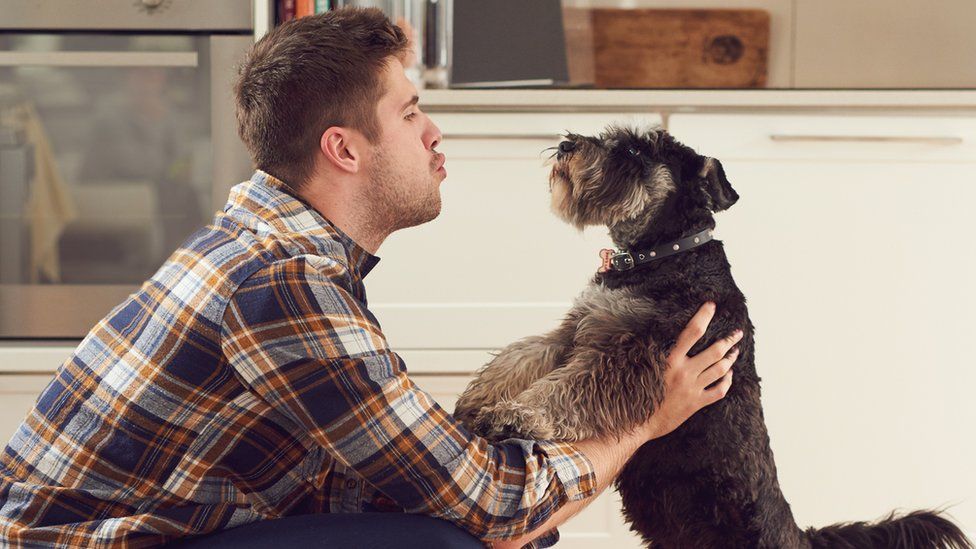So, why do we not admit to talking to our pets?
We all do it! Talk to our pets that is. Whether we confide our secrets, vent, cry with, or use a high-pitched voice telling them how cute, beautiful, or good pet they are, and giving them nicknames. It’s great to see all members of the family and even the toughest of men become all timid when engaging with their furry family member.
Sometimes it appears that our pets engage back to us with the head tilt, woofs, growls and meows, other times they look at us as if to say, “what are you doing” and give us nothing in return.
We love our pets, we go over the top to choose a name that suits, secure cosy beds, yummy food, and treats (Farmer Pete’s of course) just the way they like it, toys by the dozens, and plenty of family photos with them in it. So, why not talk to them right!

Well, if you talk to your pet, You’re not Odd – you’re Intelligent!
Research has shown that talking to our pets is not only normal, but maybe even a sign of emotional intelligence. While talking to your dog is not necessarily a sign of high intellectual intelligence, it is not a sign of low intelligence either. It is a common behaviour among many pet owners and can be considered a sign of empathy, social behaviour, and the ability to form a strong bond with another living being.
Being able to communicate effectively with your dog requires a certain level of emotional intelligence and understanding of non-verbal cues. So, while talking to your dog may not directly correlate with intelligence, it can be a positive aspect of a person's overall social and emotional intelligence.
Developing Emotional Intelligence When Talking To Your Pet Dog
Emotional intelligence is an important factor in communicating with dogs. Emotional intelligence refers to the ability to recognise, understand, and manage one's own emotions, as well as the emotions of others. When it comes to communicating with dogs, emotional intelligence can help people better understand their pet's needs, emotions, and behaviours.
One way to develop emotional intelligence when communicating with dogs is to pay attention to their body language and vocal cues. Dogs communicate through a variety of visual and auditory signals, such as wagging their tail, barking, or whining. By paying attention to these cues, people can better understand their pet's emotional state and respond appropriately.
Another important aspect of emotional intelligence when communicating with dogs is empathy. Empathy involves putting oneself in another's shoes and understanding their perspective. When people empathise with their dogs, they are better able to understand their pet's needs and emotions and respond in a way that is supportive and appropriate.
In addition to empathy and body language, emotional intelligence in communicating with dogs also involves being patient, calm, and consistent. Dogs respond best to clear and consistent communication and may become confused or anxious if they sense their owner's frustration or impatience.
Emotional intelligence is an important factor in communicating with dogs. By paying attention to their body language, empathising with their needs and emotions, and being patient and consistent in their communication, people can form a stronger bond with their pets and provide better overall care.

Humanising Our Dogs Just By Talking
Scientists say we talk to animals because we are trying to “anthropomorphise” them which means to humanise something. This is something we do naturally and from an early age. We try to humanise things such as toys, including cars, houses, boats, trees, and other everyday objects. We call them he/she, give them names, attitudes, and personalities. So why not our pets!
We say our dog is “doing a nut run”, and we ask our car “what’s wrong with it today, why won’t you start’ and call it names such as “Max the Mazda” “Kevin the KIA”. Scientists say this is just the result of having an active, intelligent social cognition — of having a brain that is programmed to see and perceive minds.”
Traditionally, anthropomorphising has been seen as a sign of childish or stupid behaviour. However, the process the brain goes through to recognise the mind of another human being involves the same psychological processes as recognising a mind in other animals. “It is a reflection of our brain’s greatest ability rather than a sign of our stupidity.”
So, the fact that we humanise our pets — to the point of conversing with them demonstrates our unique ability to connect more deeply with non-humans.
That being said, there are several ways that people tend to humanise their pets. One common way is by giving them human-like names, dressing them up in clothing, or treating them like a member of the family. People also tend to assign human emotions and motives to their pets, such as assuming that their pet is feeling sad or guilty when they exhibit certain behaviours.
While these actions may seem harmless, it's important to remember that our pets are not humans and should be treated with respect and understanding for their own unique needs and behaviours. It's important to provide our pets with proper care, training, and enrichment to ensure their physical and emotional wellbeing, rather than trying to make them more like humans.
Talking to your cat or dog is a sign of our desire for connection with them, it teaches us empathy and we show a deep love for them that only very few people are privilege to receive. As we have always though, our animals do often respond to us, and previous studies have shown that cats and dogs can read human emotion well.

So Why Do We Talk To Our Dogs?
People talk to their dogs for several reasons. One of the primary reasons is to communicate with their pets and provide verbal cues for various commands, such as sit, stay, or come.
Talking to dogs can also help reinforce good behaviour and establish a strong bond between the pet and the owner.
Additionally, people often talk to their dogs as a form of emotional support and companionship. Pets can be a great source of comfort and stress relief and talking to them can help people feel more connected and less lonely. Dogs are also known for their ability to provide unconditional love and support, which can be particularly important for people who are going through difficult times.
In addition to the reasons mentioned, people may also talk to their dogs because it can help them form a deeper understanding of their pets' behaviours and emotions. When people talk to their dogs, they may pick up on subtle cues and expressions that can help them better understand how their pet is feeling or what they need. This can be especially important when it comes to training and behaviour modification, as verbal cues and communication can be an effective way to reinforce good behaviour and address problem behaviours.
Talking to dogs can also help people feel more responsible and engaged in their pet's care. By communicating with their dogs and paying attention to their needs and behaviours, people can become more attuned to their pet's physical and emotional wellbeing. This can lead to better overall care and a stronger bond between the pet and the owner.
Overall, talking to dogs is a common and natural behaviour among many pet owners. It can provide practical benefits such as communication and training, as well as emotional benefits such as companionship and stress relief.
Some people may also talk to their dogs simply because they enjoy it. Dogs can be great listeners and talking to them can provide a sense of release and relief.
People talk to their dogs for a variety of reasons, ranging from practical communication to emotional support and companionship, it can be a fun and rewarding experience for both you and your furry friend!

Talking To Your Dog Is Not Crazy At All!
In fact, talking to your dog can be a sign of a strong bond and a healthy relationship with your pet. Communicating with your dog can also help strengthen your training and improve your dog's behaviour. However, it's important to remember that dogs don't understand language the same way humans do, so it's important to use clear body language, tone, and simple commands to communicate with them effectively.

Conclusion: Pet Talk Or No Talking
So, we should never feel childish or silly for talking to our pets. Doing so is an inherently human inclination, a sign of higher emotional intelligence, and a reflection of just how much we love and care for our furry friends. If you’re talking to your pet, you probably look at them as part of your family!
So, the next time you are talking to your pet remember this article because you are not odd or crazy – you are Intelligent!



